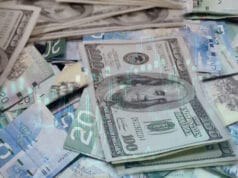Though less popular than most major pairs, the USDCHF pair is one of the easiest pairs to trade. It represents a cross between the US dollar, which is the world’s unofficial reserve currency, and the Swiss Franc, the 8th most held reserve currency. What’s more, Switzerland is a world re-known epicenter of banking and finance, while most of the world’s debt is held in USD. For that reason, this pair attracts a lot of attention from traders and investors alike.
History of USDCHF
The US dollar was introduced in 1792 as the USA’s sole currency. Unbeknownst to the world, the US would later become the world’s largest superpower. In 1944, in the heat of the Second World War, the Bretton Woods Conference was held, which tied every other country’s currency to the USD as a reserve. The USD, in turn, was backed by gold at $35/ounce. In 1971, Nixon abolished the gold standard and converted the dollar into the floating currency it is today.
The Swiss Franc was introduced in 1850 as Switzerland’s sole legal tender, replacing the numerous currencies in circulation at the time. Switzerland soon became the world’s banking haven, which has seen the CHF’s value remain among the highest in the world. It only devalued during the Depression of the 1930s, after decoupling from the gold standard. Today, it is one of the safe havens, owing largely to its stability and significance in global finance.
Why trade the USDCHF?
- It boasts high liquidity, especially in times of economic and political turmoil.
- It is sensitive to geopolitical events, making it rather predictable.
- There is no shortage of news on economic developments affecting the pair.
- It bears a close resemblance to GBP, another widely traded currency.
- It can be traded in various forms, including CFDs and options.
What moves the pair?
This pair is very popular due to its high liquidity. This means that traders can buy and sell the pair at any time without much slippage. It is also sensitive to global economic news, which gives it a sense of predictability. One such news item is the monetary policy decisions by the Fed and the Swiss National Bank (SNB). This arguably has the most effect on the pair’s price.
Additionally, news releases from the EU affect the pair, as Switzerland is one among the countries in the European Union. In the event of global economic uncertainty, the pair usually rises in value. This is because of the USD’s status as a safe haven, as well as investors channeling their money into Swiss banks. However, whenever the price of gold rises, CHF’s value tends to decline against the dollar.
The pair also bears a negative correlation to EURUSD. When EURUSD falls, USDCHF tends to rise in value, and vice versa.
Role of the USD
USD is the world’s unofficial reserve currency, as more than 60% of foreign currency reserves are in USD. The United States also holds more gold reserves than any other country and boasts the biggest economy, as well as the highest nominal GDP. There are also several nations whose currency is pegged directly to the dollar. In addition, most international transactions and debts are settled in USD.
Following its status as a safe-haven currency, investors usually turn to the dollar in the event of a global crisis. This pushes its value up against other currencies. Therefore, any changes in the dollar’s value are likely to reverberate to most other countries’ currencies.
Role of the CHF
As aforementioned, Switzerland is the world’s banking epicenter. More than 33% of the world’s privately held wealth sits in Swiss banks. CHF’s importance to world finance helps secure its place as one of the most valuable currencies globally.
CHF’s high value makes Swiss exports rather expensive. To remedy this, the SNB charges the lowest national interest rate, a cool -0.75%. Due to its role in world finance, the CHF is as global a currency as the USD. This means it is also affected by global economic news, which further adds to the pair’s volatility.
When to buy/sell the pair
As aforementioned, the USDCHF pair is affected by major world economic news, as well as local US and Swiss economic developments. Gold prices and interest rates from the Fed and SNB also move the pair’s price. Further, it is closely correlated with other major pairs such as GBPUSD and EURUSD.
If you speculate that the SNB is about to raise interest rates, you should buy the USDCHF pair. This is because such a move could negatively impact Swiss trade, which will raise USD’s value against the Franc. Alternatively, if you believe that Non-Farm payroll data from the US is going to be lower than expected, you should sell the pair as this would mean the USD is going to fall against the Swiss Franc.
Risks associated with the USDCHF trade
This pair is characterized by relatively low volatility. This means it does not present much potential for profit from its price moves. Therefore, you should not expect large profits from one single trade in the pair.
Both currencies are considered safe havens by numerous other countries. Therefore, during times of economic turmoil, one may be faced with a dilemma as to which currency to buy and which to sell.
Lastly, beware of taking on too much leverage when trading the USDCHF pair. Leverage may amplify your profits, but it may also make your losses that much more detrimental.
Conclusion
The USDCHF pair is one of the most interesting pairs to trade. The USD is the global reserve currency and is widely used across the globe to settle debts and complete transactions. The CHF, on the other hand, is the currency of the world’s largest banking and financial center. The pair enjoys high liquidity, which means traders can easily trade it even in large amounts with reduced slippage. It is also easily predictable owing to its sensitivity to global economic news. When trading the pair, do not expect large profits from a single trade, as its volatility is relatively low.




